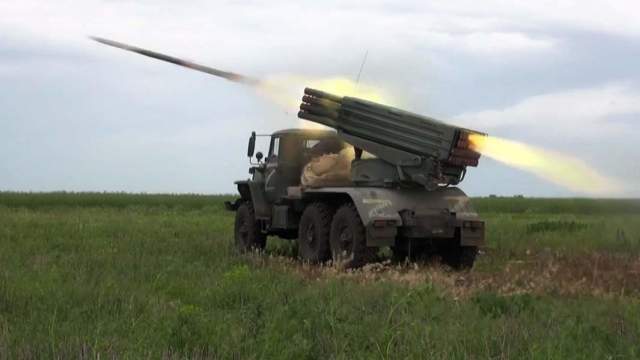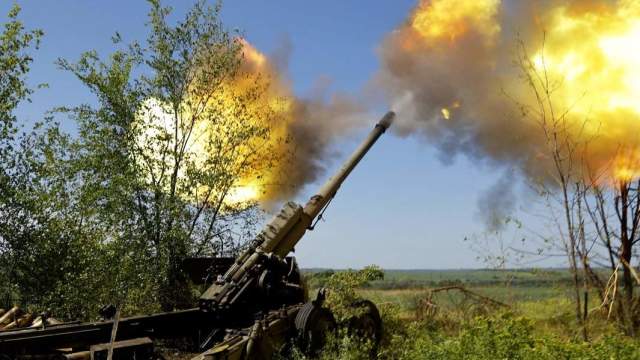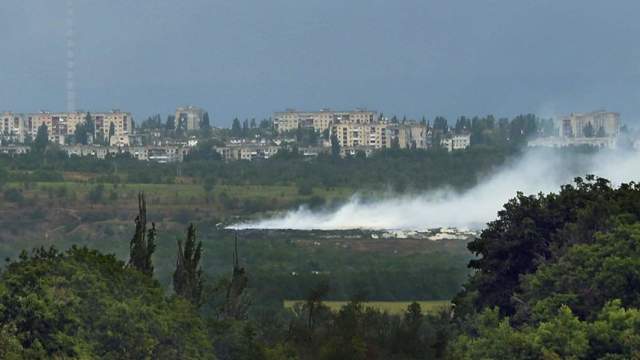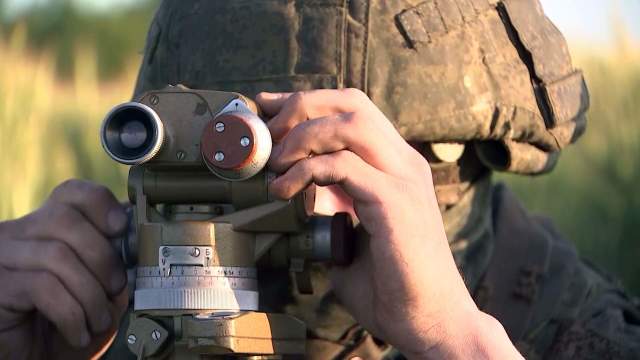A correspondent of Izvestia observed artillery duels during the stripping of the boiler at Gorsky and Zolotoy
Powerful artillery support played a crucial role in the recent successes of the allied forces on the "Donbass Arc" — according to the Russian Defense Ministry, Gorskoye and Zolotoye were liberated on June 25, and developing the success, the troops blocked the city of Lisichansk from the south. About how the artillery supported the offensive on these settlements, what role the capture of Popasna, which happened back in May, played in the current victory, and why it is still dangerous on the streets of this city, although the front has gone quite far ahead, is in the report of Izvestia from the positions of Russian troops.
Fire offensive
The fate of the city of Popasnaya with a once 45-thousand population is best demonstrated by a large-scale stele with the name of the settlement. Right in front of her, the Ukrainians have set up a strong point with concrete pillboxes. Now they lie in ruins, but the huge metal letters have not survived either. Standing, and even then leaning, only the last AYA remained.
The artillery, located near Popasnaya and continuously maneuvering, works constantly. Before reaching the city, we put on bulletproof vests and helmets in a relatively safe place. At this moment, the Grad, hidden somewhere very close behind the forest belt, releases half of its ammunition with a characteristic roar. Then such sounds and the sight of missiles flying away towards the enemy will haunt us all day. A full volley of 40 "hailstones" lasts 20 seconds, so you learn very quickly by ear to determine the approximate amount of ammunition fired.

Operation of the Grad multiple launch rocket system
Image source: Photo: RIA Novosti/Ministry of Defense of the Russian Federation
Again we meet several art systems with floral names. 122-millimeter self-propelled guns "Carnation" also work from roadside bushes. A little further in the rear, we find powerful self-propelled guns "Hyacinth-S" on the redeployment. Formidable 152-millimeter howitzers, due to the high range of fire, are often used specifically to suppress enemy artillery.
The more familiar towed "Msta-B", as well as self-propelled "Msta-S" loaded on trawl trucks are constantly cruising along the frontline roads.
— In this direction, the front line is 12 km away, — the DPR artillery officer shows us in the direction of Bakhmut. — But in the direction of Zolotoye and Kamyshevakha, the enemy is only 5 km away. His sabotage and reconnaissance groups were approaching us along the railway and 1.5–2 km away.
The fact that the front line is very close is also indicated by the regular whiplash of 120-millimeter mortars. Their maximum firing range is 7 km. It is not possible to see the positions just like that. All the artillery systems are well camouflaged, and they can only be noticed at the relocation.
Clouds of black smoke are rising on the horizon from Artemovsk and the cleaned Kamyshevakha. The artillery found its targets.

Shot from 152-mm gun 2A36 "Hyacinth-B"
Image source: Photo: RIA Novosti/Sergey Averin
The enemy's return fire is weak and disorganized. It is felt that in this key area his artillery was under strong pressure and cannot conduct a fire duel on equal terms. This is also confirmed from the opposite side.
— For 100 shells from your side, only seven or eight of ours flew, 20 at most, - a soldier of the 24th mechanized Brigade of the Armed Forces of Ukraine, who surrendered at a press conference in Lugansk on June 24, said at a press conference in Lugansk. — Yes, and that half did not reach the targets. Sometimes the Ukrainian artillery hit its own.
Crushing Ruins
At the same time, there are still arrivals on Popasnaya. The enemy is trying to hit the artillery dispersed around, as well as to kill the offensive supply line passing through it. We drive into the city to see how much it has suffered. The center and the private sector are studded with aluminum "pencils" of 220-millimeter Uragan rockets with a cluster warhead sticking out of the ground. This weapon is designed to strike areas from a long distance.
— I was in Mariupol, the destruction is stronger here, — a DPR officer with the call sign Sochi shares his impressions with us. — There is not a single whole high-rise building left.
Comparison with Severodonetsk and Rubezhny is also not in favor of Popasnaya. In them, the residential sector suffered less. Nevertheless, Ukrainian ammunition is still falling on the already destroyed city every day.
— This rocket flew here yesterday, — Sochi shows us the remnants of the cassette Hurricane. — And the shells from foreign howitzers hit that nine-story building the day before yesterday, the ceilings in the whole section collapsed.
A destroyed house on one of the streets in Mariupol
Image source: Photo: RIA Novosti/Pavel Lisitsyn
On the memorial in the center of Popasnaya there is a deep five-meter funnel from a heavy munition that arrived from Ukraine. The military notes that this is definitely not from an air bomb, but they are at a loss to guess whether it was a rare 203-millimeter "Peony" gun or a Tochka-U ballistic missile strike with a high-explosive warhead. There were no casualties from the hit, he damaged only the memorial.
A month ago, our driver lit a candle in the damaged church and prayed in front of the surviving iconostasis. Now, after the Ukrainian shelling, only the burnt walls of the church remain.
There are very few residents left in the destroyed city. This is also not similar to Severodonetsk or Rubezhnoye. In one of the dilapidated five—story buildings there was a small commune of five people, one of them is a walking old man.
— We have food, we would like a couple of bags of bleach ... - says local resident Nikolai.
Right at the entrance to the flower bed there are two homemade crosses. Here, in 40-centimeter graves under shelling, the elderly who died in the basements where people moved to live were buried in a hurry. They were not killed by shell fragments — their hearts could not stand it. With the onset of 33-degree heat, the insufficient depth of the burial began to affect.
It has not yet been possible to resolve the issue of organized reburials in the frontline city under Ukrainian fire.
Flower of Victory
On the bypass road around Popasnaya, three lines of defense are visible with typical concrete pillboxes that reliably protect against artillery shelling. Those that are not destroyed by air strikes are riddled with potholes from shrapnel and small-caliber shells. There are still a lot of anti-tank weapons near each line of defense. Foreign grenade launchers have long been collected by souvenir lovers, but there are a lot of tubes with unused Soviet anti-tank guided missiles. Along the roads, even with the naked eye, whole deposits of anti-tank mines with screwed-in fuses are visible. There is still no time to clear all these explosive "gifts".

View of Lisichansk from the Lisichansk–Zolotoe highway
Image source: Photo: RIA Novosti/Viktor Antonyuk
The battles for Popasnaya lasted more than two months. The breakthrough of the positions of the Ukrainian 24th mechanized brigade and the National Guard here predetermined the success of the entire offensive on the "Donbass arc". It was from here that the "Popasnaya Flower" began to unfold — a simultaneous offensive in three main directions through a gap punched in the defense line of the Ukrainian troops.
In one direction, this allowed us to take the city of Svetlodarsk without a fight and damage. On the other — to go to Artemovsk (Bakhmut) and cut the main road along which the VFU group was supplied in Severodonetsk and Lisichansk.
And finally, the third strike in the direction of Gorsky and Zolotoye allowed to close the cauldron of encirclement around these cities, which were well fortified in previous years, and by the end of this week to capture and defeat the armed formations of Ukraine holding them.
Now the artillery group near Popasna will switch to supporting the attack on Artemovsk and closing the boiler around Lisichansk.
Anton Lavrov

